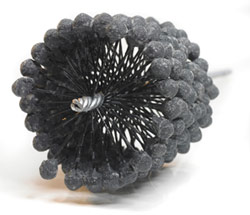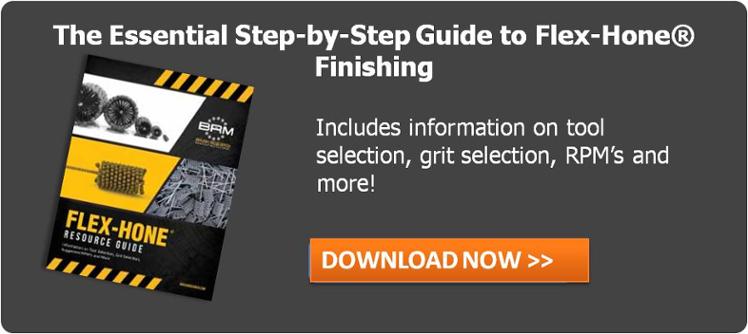 BRM Flex-Hone® tools come in 10 abrasive types and 11 grit sizes. When it's time to select and use a flexible cylinder hone, remember these two rules about deburring and surface finishing.
BRM Flex-Hone® tools come in 10 abrasive types and 11 grit sizes. When it's time to select and use a flexible cylinder hone, remember these two rules about deburring and surface finishing.
- The base material of your workpiece determines which abrasive type to select.
- The amount of work to perform and the degree of surface improvement that’s required determines which grit size – or sizes – to use.
Here’s what else you need to know about abrasives and grits for Flex-Hone® tools.
Abrasive Types and Base Materials
Flex-Hone® tools feature abrasive globules or balls that provide a soft cutting action. That's why these flexible resilient honing tools are sometimes called ball hones or dingleberry hones.
This table lists all 10 Flex-Hone® abrasive types and the base materials that are suitable for each.
|
Use This Abrasive Type |
With These Base Materials |
|
Silicon Carbide (SC) |
Cast iron Mild steel Stainless steel |
|
Aluminum Oxide (AO) |
Aluminum Brass Bronze Softer metals |
|
Zirconia Alumina (Z-Grain) No. 1525 |
Cast iron Low carbon steels Medium carbon steels Stainless steel |
|
Zirconia Alumina (Z-Grain) |
Cast iron Low carbon steels Medium carbon steels Stainless steel |
|
Boron Carbide (BC) |
Medium carbon steels High carbon steels Heat-treated steels to 50 Rc Titanium |
|
Tungsten Carbide (WC) |
High carbon steel alloys More exotic space age alloys |
|
Levigated Alumina (LA) |
Many materials (final polishing) |
|
Diamond |
Carbide Ceramic Hardened tool steel Heat treated steel |
|
Cubic Boron Nitride (CBN) |
Harder materials |
|
Ceramic |
Harder materials |
As the table above shows, some base materials can be deburred and surface finished with more than one abrasive type. If you have questions about which abrasive type to choose for your Flex-Hone® application, contact BRM.
Grit Sizes and Finishing Requirements
Grit size refers to an abrasive’s average particle diameter. The terms coarse, medium, and fine are used to describe these different sizes. With diamond abrasive, particular sizes are measured by mesh instead. For both grit sizes and mesh sizes, larger numbers (e.g., 800) indicate smaller particle sizes and finer abrasive products. Smaller grit (e.g., 20) or mesh sizes are coarser and have larger particles.
If the starting finish is rough but a significantly finer finish is required, use Flex-Hone® tools in multiple grit sizes. As a rule, start with a lower-grit Flex-Hone® and then use one or more higher-grit tools until the final finish is achieved. Using a fine-grit tool followed by a coarse-grit tool is less effective on surfaces that require significant improvement.
To learn which grit sizes are available for each abrasive, download the Flex-Hone Resource Guide.









